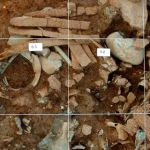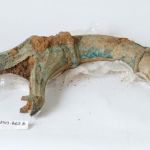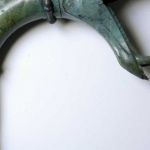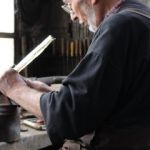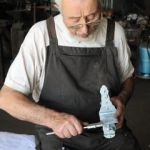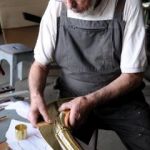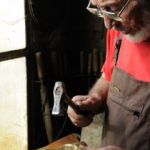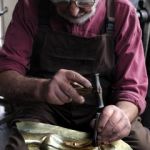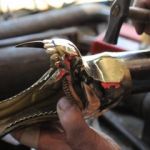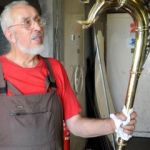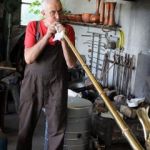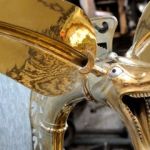
The Carnyx from Tintignac
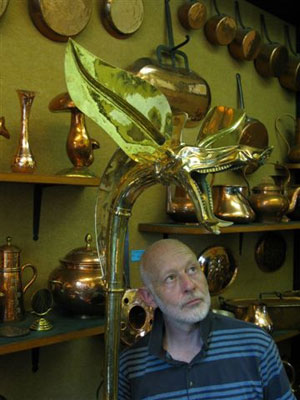 As a member of EMAP (European Music Archaeology Project) John Kenny has helped to bring to fruition the reconstruction of the magnificent Tintignac Carnyx, and from autumn 2014 he will be giving performances and lecture recitals throughout Europe. The instrument has been reconstructed by Jean Boisserie, based upon the research of a French team of scientists, led by the archaeologist Christophe Maniquet.
As a member of EMAP (European Music Archaeology Project) John Kenny has helped to bring to fruition the reconstruction of the magnificent Tintignac Carnyx, and from autumn 2014 he will be giving performances and lecture recitals throughout Europe. The instrument has been reconstructed by Jean Boisserie, based upon the research of a French team of scientists, led by the archaeologist Christophe Maniquet.Until 2004, fragments of only five carnyces had been preserved, from modern Scotland, France, Germany, Romania and Switzerland, but in November 2004 archaeologists discovered a first-century-BC deposit of seven more of these extraordinary instruments under a Gallo-Roman fanum at Tintignac in the Corrèze region of southern France. Although all are ritually dismembered, one is almost complete. Six of these carnyces have boar's heads, but the seventh is a serpent-like fantasy beast. The find appears to represent a ritual deposit dating to soon after the Roman conquest of Gaul. The Tintignac finds enabled some fragments found decades before at Sanzeno in northern Italy to be identified as coming from two carnyces. The first reconstruction in brass of a “Sanzeno Carnyx” has also been made by the scholar and craftsman Alessandro Ervas, as a contributor of the research team of the Soprintendenza per i Beni architettonici e archeologici della Provincia autonoma di Trento, led by the archaeologists Paolo Bellintani e Rosa Roncador.
The Gallic and Gallo-Roman site of Tintignac is located on the plateau of Naves, north of the towns of Naves and Tulle, in the foothills east of Puy l'Aiguille, west of the Peuch Redon summit. Around the sanctuary researchers have discovered traces of dense occupation and activity.
In September 2004 over 500 fragments of iron and bronze objects were discovered in a Gallic pit. The objects included a dozen swords and scabbards, iron spearheads, a shield, ten bronze helmets and an iron bird (a Crane or Swan is found on some Lemovices items), 2 animal heads including a horse, one animal body in connection with the two hind legs, one foreleg, a cauldron, and seven Carnyces, one of which is almost complete. These unique military and religious objects are currently being studied by Christophe Maniquet’s team, and are in the process of conservation and restoration by the Materia Viva laboratory in Toulouse.
The word “carnyx” appears in various classical texts: carnyces are described as being present at the Celtic attack on the Delphi in 279 BC, as well as from Julius Caesar's campaign in Gaul and Claudius' invasion of Britain. Diodorus Siculus around 60-30 BC wrote:
"Their trumpets again are of a peculiar barbarian kind; they blow into them and produce a harsh sound which suits the tumult of war”
The Deskford Carnyx was found at the farm of Leitchestown, Deskford, Banffshire, Scotland in 1816. Only the boar's head bell survives, also apparently placed as a ritual deposit. It was donated to Banff Museum, and is now on loan from Aberdeenshire Museums Service to the Museum of Scotland. Two reconstructions have been made by John Creed, using materials and techniques as close as possible to the original. One is on permanent display in the National Museum of Scotland, the other is in the keeping of Carnyx & Co, and is used by John Kenny for performances, lectures and research.
It is clear from our work in Scotland, France and Italy that people of Celtic culture all over ancient Europe were fascinated by lip reed instruments, and made great horns and trumpets in many forms. The lower parts of the Deskford Carnyx were modelled upon the images of the Gundestrup Cauldron, where we see three men playing the instrument vertically. The structure of the Deskford head makes this interpretation logical – but the Tintignac Carnyx is clearly a different beast. The lower tubes are completely straight, terminating in a fixed, integral mouthpiece. This makes it virtually impossible to play vertically, thus although its head looks like the Gundestrup instruments, it must have been played at an angle closer to horizontal. The magnificent head of the Tintignac features gaping jaws and huge, delicate ears – and yet the structure is far less complex than the Deskford head, with its hinged jaw, sprung tongue, soft palette and brain cavity.
Jean Boisserie’s Tintignac Carnyx reconstruction is made entirely of hand hammered bronze. It is a vibrant, living musical instrument. The exciting task ahead is the exploration of its acoustic and expressive capabilities - to give the Tintignac carnyx a voice!
Cries - Tintignac Carnyx played by John Kenny (0:30)
In The Woods - Tintignac Carnyx played by John Kenny (1:18)
Pulse - Tintignac Carnyx played by John Kenny (1:28)
Reconstruction of the Tintignac Carnyx recorded by Alberto Morelli at the Officina delle Arti e dei Mestieri Sebastian Matta, Tarquinia (IT), November, 2015.
Photo courtesy of Carnyx & Co.©



